
Concept explainers
(a)
Interpretation:
The most acidic proton, in the given species, is to be identified, and its pKa value is to be estimated.
Concept introduction:
An Acidic proton is one which is directly bonded to an electronegative atom. The acidity of a compound is governed largely by the
Answer to Problem 6.50P
The most acidic proton in the given species along with its estimated pKa value is:
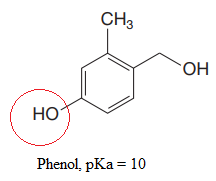
Explanation of Solution
The structure for the given compound is:
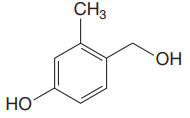
There are three protons that could be acidic. The proton attached to the carbon in methyl group, to the oxygen atom in alcohol, and the proton directly attached to the oxygen atom in phenol functional group are the protons that could be acidic.
According to Table 6-1, the relative pKa value of each of the protons is:
The pKa value for the compound having
The pKa value for the compound having
The pKa value for the compound having
Lower the pKa value, stronger is the acid, and the proton associated with it is the most acidic proton. The lowest pKa value is for

The most acidic proton in the given structure is identified along with its estimated pKa value using Table 6-1.
(b)
Interpretation:
The most acidic proton in the given species is to be identified and its pKa value is to be estimated.
Concept introduction:
An Acidic proton is the one which is directly bonded to an electronegative atom. The acidity of a compound is governed largely by the functional group on which the acidic proton is found. Nearby structural features such as highly electronegative substituent or presence of a double or triple bond can alter the acidity significantly. The pKa value for a particular compound is explained based on structural similarities of the compound and the compounds listed in Table 6-1.
Answer to Problem 6.50P
The most acidic proton in the given species along with its estimated pKa value is:
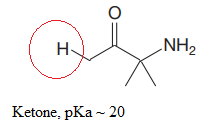
Explanation of Solution
The structure for the given compound is:

In the given structure, the proton attached to the nitrogen atom, and to the carbon atom next to the carbonyl group, could be the acidic protons.
According to Table 6-1, the relative pKa value of each of the protons is:
The pKa value for the compound having
The pKa value for the compound having
Lower the pKa value, stronger is the acid, and the proton associated with it is the most acidic proton. The lowest pKa value is for

The most acidic proton in the given structure is identified along with its estimated pKa value using Table 6-1.
(c)
Interpretation:
The most acidic proton in the given species is to be identified and its pKa value is to be estimated.
Concept introduction:
An Acidic proton is the one which is directly bonded to an electronegative atom. The acidity of a compound is governed largely by the functional group on which the acidic proton is found. Nearby structural features such as highly electronegative substituent or presence of a double or triple bond can alter the acidity significantly. The pKa value for a particular compound is explained based on structural similarities of the compound and the compounds listed in Table 6-1.
Answer to Problem 6.50P
The most acidic proton in the given species along with its estimated pKa value is:
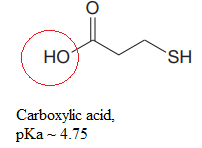
Explanation of Solution
The structure for the given compound is:

There are two protons that could be acidic. The proton attached to the oxygen atom which is directly bonded to the carbonyl group, and to the sulfur atom are the protons that could be acidic.
According to Table 6-1, the relative pKa value of each of the protons is:
The pKa value for the compound having
The pKa value for the compound having
Lower the pKa value, stronger is the acid and the proton associated with it is the most acidic proton. The lowest pKa value is for

The most acidic proton in the given structure is identified along with its estimated pKa value using Table 6-1.
(d)
Interpretation:
The most acidic proton in the given species is to be identified and its pKa value is to be estimated.
Concept introduction:
An Acidic proton is the one which is directly bonded to an electronegative atom. The acidity of a compound is governed largely by the functional group on which the acidic proton is found. Nearby structural features such as highly electronegative substituent or presence of a double or triple bond can alter the acidity significantly. The pKa value for a particular compound is explained based on structural similarities of the compound and the compounds listed in Table 6-1.
Answer to Problem 6.50P
The most acidic proton in the given species along with its estimated pKa value is:
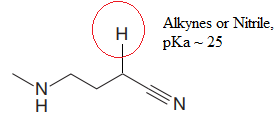
Explanation of Solution
The structure for the given compound is:

In the given structure, the proton attached to the nitrogen atom and to the triple bonded carbon atom could be the acidic protons.
According to Table 6-1, the relative pKa value of each of the protons is:
The pKa value for the compound having
The pKa value for the compound having
Lower the pKa value, stronger is the acid and the proton associated with it is the most acidic proton. The lowest pKa value is for

The most acidic proton in the given structure is identified along with its estimated pKa value using Table 6-1.
(e)
Interpretation:
The most acidic proton in the given species is to be identified and its pKa value is to be estimated.
Concept introduction:
An Acidic proton is the one which is directly bonded to an electronegative atom. The acidity of a compound is governed largely by the functional group on which the acidic proton is found. Nearby structural features such as highly electronegative substituent or presence of a double or triple bond can alter the acidity significantly. The pKa value for a particular compound is explained based on structural similarities of the compound and the compounds listed in Table 6-1.
Answer to Problem 6.50P
The most acidic proton in the given species along with its estimated pKa value is:
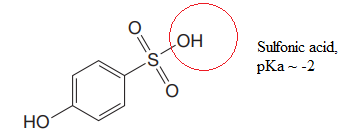
Explanation of Solution
The structure for the given compound is:
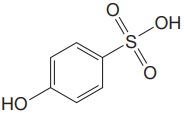
There are two protons that could be acidic. The proton attached to the carbon in methyl group, to the oxygen atom in alcohol, and the proton directly attached to the oxygen atom in phenol functional group are the protons that could be acidic.
According to Table 6-1, the relative pKa value of each of the protons is:
The pKa value for the compound having
The pKa value for the compound having
Lower the pKa value, stronger is the acid and the proton associated with it is the most acidic proton. The lowest pKa value is for

The most acidic proton in the given structure is identified along with its estimated pKa value using Table 6-1.
(f)
Interpretation:
The most acidic proton in the given species is to be identified and its pKa value is to be estimated.
Concept introduction:
An Acidic proton is the one which is directly bonded to an electronegative atom. The acidity of a compound is governed largely by the functional group on which the acidic proton is found. Nearby structural features such as highly electronegative substituent or presence of a double or triple bond can alter the acidity significantly. The pKa value for a particular compound is explained based on structural similarities of the compound and the compounds listed in Table 6-1.
Answer to Problem 6.50P
The most acidic proton in the given species along with its estimated pKa value is:
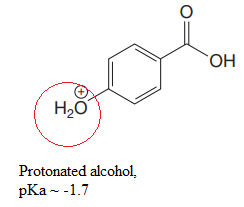
Explanation of Solution
The structure for the given compound is:
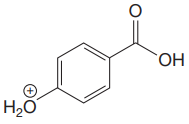
There are two protons that could be acidic. The proton attached to the carbon in methyl group, to the oxygen atom in alcohol, and the proton directly attached to the oxygen atom in phenol functional group are the protons that could be acidic.
According to Table 6-1, the relative pKa value of each of the protons is:
The pKa value for the compound having protonated
The pKa value for the compound having
Lower the pKa value, stronger is the acid and the proton associated is the most acidic proton. The lowest pKa value is for protonated

The most acidic proton in the given structure is identified along with its estimated pKa value using Table 6-1.
(g)
Interpretation:
The most acidic proton in the given species is to be identified and its pKa value is to be estimated.
Concept introduction:
An Acidic proton is the one which is directly bonded to an electronegative atom. The acidity of a compound is governed largely by the functional group on which the acidic proton is found. Nearby structural features such as highly electronegative substituent or presence of a double or triple bond can alter the acidity significantly. The pKa value for a particular compound is explained based on structural similarities of the compound and the compounds listed in Table 6-1.
Answer to Problem 6.50P
The most acidic proton in the given species along with its estimated pKa value is:
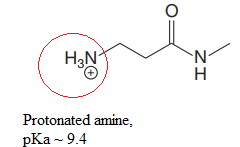
Explanation of Solution
The structure for the given compound is:

In the given structure, the proton attached to both nitrogen atoms could be acidic protons.
According to Table 6-1, the relative pKa value of each of the protons is:
The pKa value for the compound having protonated
The pKa value for the compound having
Lower the pKa value, stronger is the acid and the proton associated with it is the most acidic proton. The lowest pKa value is for protonated

The most acidic proton in the given structure is identified along with its estimated pKa value using Table 6-1.
(h)
Interpretation:
The most acidic proton in the given species is to be identified and its pKa value is to be estimated.
Concept introduction:
An Acidic proton is the one which is directly bonded to an electronegative atom. The acidity of a compound is governed largely by the functional group on which the acidic proton is found. Nearby structural features such as highly electronegative substituent or presence of a double or triple bond can alter the acidity significantly. The pKa value for a particular compound is explained based on structural similarities of the compound and the compounds listed in Table 6-1.
Answer to Problem 6.50P
The most acidic proton in the given species along with its estimated pKa value is:
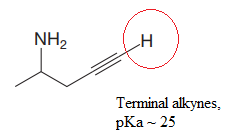
Explanation of Solution
The structure for the given compound is:

In the given structure, the protons attached to the terminal triple bonded carbon atom and to the nitrogen atom could be acidic protons.
According to Table 6-1, the relative pKa value of each of the protons is:
The pKa value for the compound having protonated
The pKa value for the compound having
Lower the pKa value, stronger is the acid and the proton associated with it is the most acidic proton. The lowest pKa value is for

The most acidic proton in the given structure is identified along with its estimated pKa value using Table 6-1.
Want to see more full solutions like this?
Chapter 6 Solutions
Get Ready for Organic Chemistry
- Predict the major products of the following organic reaction: NC Δ ? Some important Notes: • Draw the major product, or products, of the reaction in the drawing area below. • If there aren't any products, because no reaction will take place, check the box below the drawing area instead. • Be sure to draw bonds carefully to show important geometric relationships between substituents. Note: if your answer contains a complicated ring structure, you must use one of the molecular fragment stamps (available in the menu at right) to enter the ring structure. You can add any substituents using the pencil tool in the usual way. Click and drag to start drawing a structure. Х аarrow_forwardPredict the major products of this organic reaction. Be sure you use dash and wedge bonds to show stereochemistry where it's important. + ☑ OH 1. TsCl, py .... 文 P 2. t-BuO K Click and drag to start drawing a structure.arrow_forwardConsider this organic reaction: ( Draw the major products of the reaction in the drawing area below. If there won't be any major products, because this reaction won't happen at a significant rate, check the box under the drawing area instead. Click and drag to start drawing a structure. Х : а ค 1arrow_forward
- In the drawing area below, draw the major products of this organic reaction: If there are no major products, because nothing much will happen to the reactant under these reaction conditions, check the box under the drawing area instead. 1. NaH 2. CH3Br ? Click and drag to start drawing a structure. No reaction. : ☐ Narrow_forward+ Predict the major product of the following reaction. : ☐ + ☑ ค OH H₂SO4 Click and drag to start drawing a structure.arrow_forwardConsider this organic reaction: ... OH CI Draw the major products of the reaction in the drawing area below. If there won't be any major products, because this reaction won't happen at a significant rate, check the box under the drawing area instead. ☐ No Reaction. Click and drag to start drawing a structure. : аarrow_forward
- Consider the following reactants: Br Would elimination take place at a significant rate between these reactants? Note for advanced students: by significant, we mean that the rate of elimination would be greater than the rate of competing substitution reactions. yes O no If you said elimination would take place, draw the major products in the upper drawing area. If you said elimination would take place, also draw the complete mechanism for one of the major products in the lower drawing area. If there is more than one major product, you may draw the mechanism that leads to any of them. Major Products:arrow_forwardDraw one product of an elimination reaction between the molecules below. Note: There may be several correct answers. You only need to draw one of them. You do not need to draw any of the side products of the reaction. OH + ! : ☐ + Х Click and drag to start drawing a structure.arrow_forwardFind one pertinent analytical procedure for each of following questions relating to food safety analysis. Question 1: The presence of lead, mercury and cadmium in canned tuna Question 2: Correct use of food labellingarrow_forward
- Formulate TWO key questions that are are specifically in relation to food safety. In addition to this, convert these questions into a requirement for chemical analysis.arrow_forwardWhat are the retrosynthesis and forward synthesis of these reactions?arrow_forwardWhich of the given reactions would form meso product? H₂O, H2SO4 III m CH3 CH₂ONa CH3OH || H₂O, H2SO4 CH3 1. LiAlH4, THF 2. H₂O CH3 IVarrow_forward
 Organic Chemistry: A Guided InquiryChemistryISBN:9780618974122Author:Andrei StraumanisPublisher:Cengage Learning
Organic Chemistry: A Guided InquiryChemistryISBN:9780618974122Author:Andrei StraumanisPublisher:Cengage Learning Organic ChemistryChemistryISBN:9781305580350Author:William H. Brown, Brent L. Iverson, Eric Anslyn, Christopher S. FootePublisher:Cengage Learning
Organic ChemistryChemistryISBN:9781305580350Author:William H. Brown, Brent L. Iverson, Eric Anslyn, Christopher S. FootePublisher:Cengage Learning


